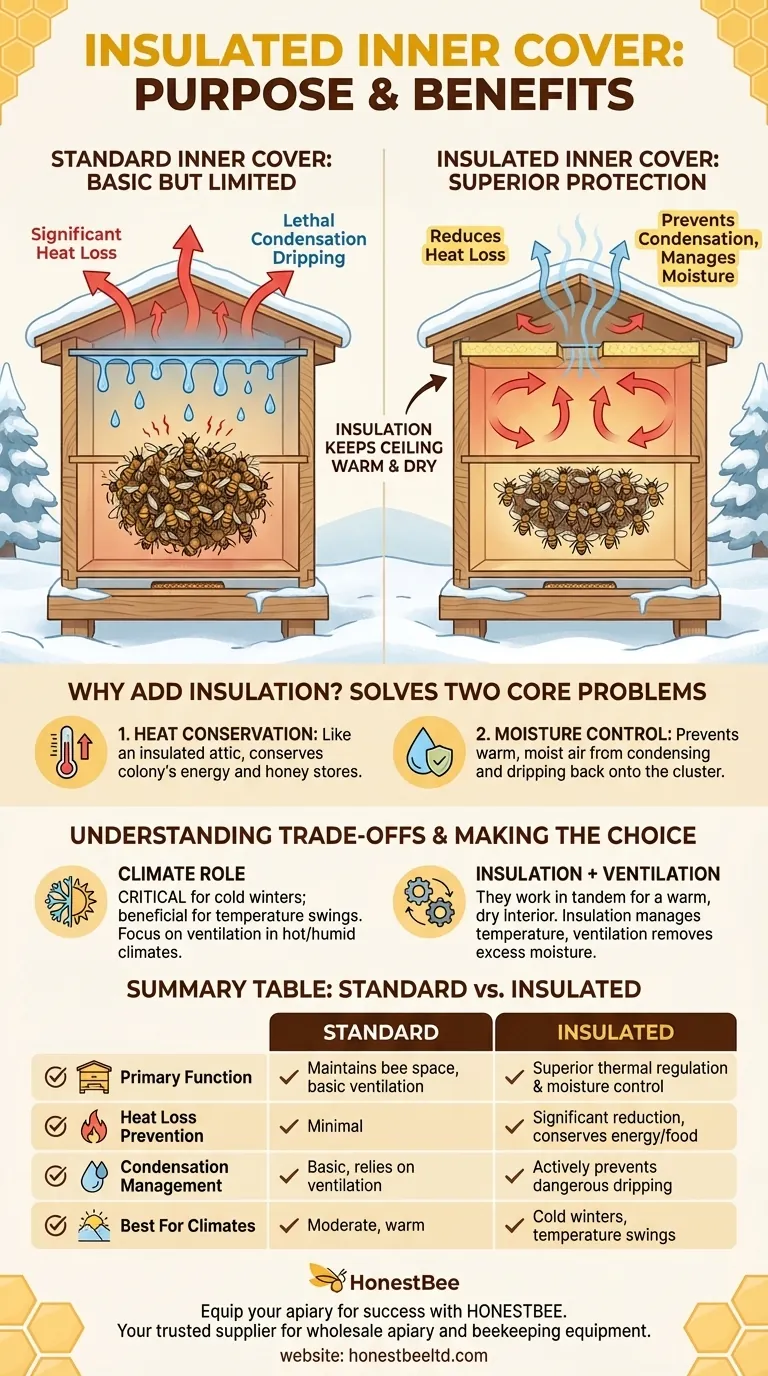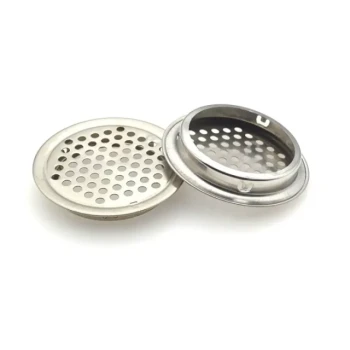The primary purpose of an insulated inner cover is to provide superior thermal regulation for a beehive, significantly reducing heat loss in the winter and helping to manage condensation. It creates a more stable internal environment, which allows the colony to expend less energy on maintaining temperature.
The core problem an insulated inner cover solves is not just heat loss, but the dangerous combination of heat loss and internal moisture. It keeps the hive ceiling warm, preventing condensation from forming and dripping back down onto the bee cluster.

The Standard Inner Cover: A Baseline
Before understanding the value of insulation, we must first understand the role of any standard inner cover. It is a multi-function tool placed directly on top of the uppermost hive box, just beneath the main telescoping outer cover.
Providing "Bee Space"
The inner cover is designed to maintain a specific gap, known as "bee space," between the top of the frames and the outer lid. This discourages the bees from gluing the outer cover to the hive body with propolis or building unwanted comb in that area.
Facilitating Hive Inspections
This separation makes opening the hive much easier and less disruptive for the colony. Beekeepers can gently pry off the outer cover without jarring the entire hive or rolling bees.
Enabling Ventilation and Feeding
Most inner covers have a central hole for placing a feeder and a notched rim that can create a small upper entrance for ventilation and bee traffic. This basic ventilation is crucial for air exchange within the hive.
Why Add Insulation? The Two Core Problems It Solves
While a standard inner cover provides basic functions, adding a layer of insulation—typically rigid foam—dramatically enhances its performance, especially in climates with cold winters.
Problem #1: Reducing Heat Loss
Bees do not heat the entire hive; they form a tight cluster and vibrate their wing muscles to generate heat, keeping the cluster's core at a stable temperature. This process consumes a significant amount of their stored honey.
An insulated inner cover acts like insulation in the attic of a house. It dramatically reduces the amount of heat that escapes through the top of the hive, allowing the colony to conserve its energy and food stores.
Problem #2: Preventing Lethal Condensation
As bees respire and metabolize honey, they release warm, moist air. This air rises and, in a hive with a cold top, will hit the cold surface and condense into water droplets.
This cold water can then drip back down onto the winter cluster, chilling and killing the bees. An insulated inner cover keeps the interior ceiling of the hive warmer, above the dew point, preventing this condensation from forming directly over the colony. The moisture can then exit the hive through proper ventilation points.
Understanding the Trade-offs
While highly beneficial, an insulated inner cover's value depends on your climate and management style.
The Role of Climate
In regions with harsh, cold winters, an insulated inner cover is a critical piece of equipment for improving the odds of colony survival.
In very hot and humid climates, its benefits are less pronounced. While it can help buffer against extreme heat, the primary focus in such environments shifts entirely to maximizing ventilation to prevent overheating.
Insulation and Ventilation Work Together
Adding insulation does not eliminate the need for proper hive ventilation. An insulated, well-ventilated hive is the goal.
The insulation manages the temperature gradient, while the ventilation (like an upper entrance) allows excess moist air to escape. The two systems work in tandem to create a warm but dry interior environment.
Making the Right Choice for Your Goal
Ultimately, the decision to use an insulated inner cover depends on the specific environmental challenges your bees face.
- If your primary focus is winter survival in a cold climate: An insulated inner cover is one of the most effective tools you can use to help your bees conserve resources and manage moisture.
- If your primary focus is general beekeeping in a moderate climate: A standard inner cover may be sufficient, but an insulated model can still provide benefits by buffering the colony from drastic temperature swings in spring and fall.
By controlling heat and moisture, you create a more stable and resource-efficient home for your colony.
Summary Table:
| Feature | Standard Inner Cover | Insulated Inner Cover |
|---|---|---|
| Primary Function | Maintains bee space; basic ventilation | Superior thermal regulation & moisture control |
| Heat Loss Prevention | Minimal | Significant reduction, conserves bee energy/food |
| Condensation Management | Basic, relies on ventilation | Actively prevents dangerous dripping on the cluster |
| Best For Climates | Moderate, warm climates | Cold winters, climates with temperature swings |
Equip your apiary for success with HONESTBEE.
An insulated inner cover is a key component for resilient colonies. As a trusted supplier for commercial apiaries and beekeeping equipment distributors, HONESTBEE provides the high-quality, wholesale-focused supplies you need to optimize hive health and productivity.
Let's discuss how our equipment can support your operations. Contact our team today to learn more about our product range and wholesale options.
Visual Guide

Related Products
- Inner Beehive Cover for Beekeeping Bee Hive Inner Cover
- Professional Insulated Winter Hive Wrap for Beekeeping
- Stainless Steel Round Beehive Air Vents for Ventilation
- Professional Galvanized Hive Strap with Secure Locking Buckle for Beekeeping
- Professional Drop-Style Hive Handles for Beekeeping
People Also Ask
- What is the function of an inner cover in a beehive? Essential for Hive Health & Management
- What is the role of inner covers in insulated beehives? Master Moisture Control for a Healthy Colony
- What is the function of the center hole in the inner cover? Master Hive Ventilation and Feeding
- What is an inner cover in a beehive and what are its features? A Key Tool for Hive Health & Management
- What is the role of the inner cover in a beehive? Essential Climate Control for Hive Health



















